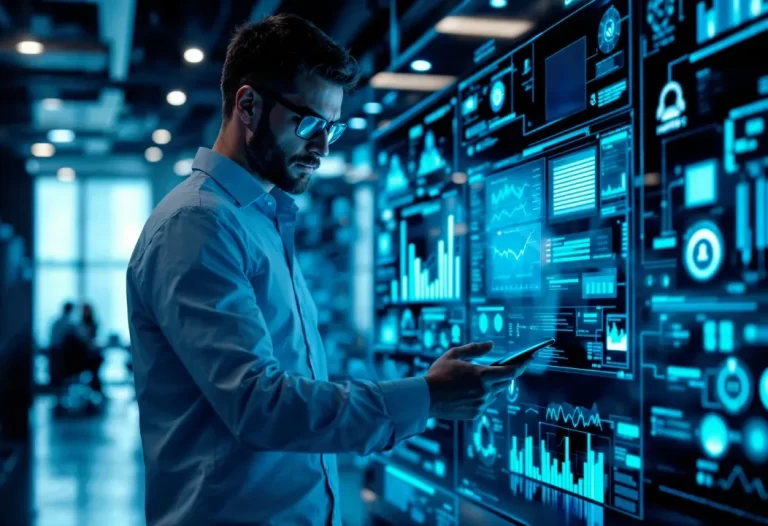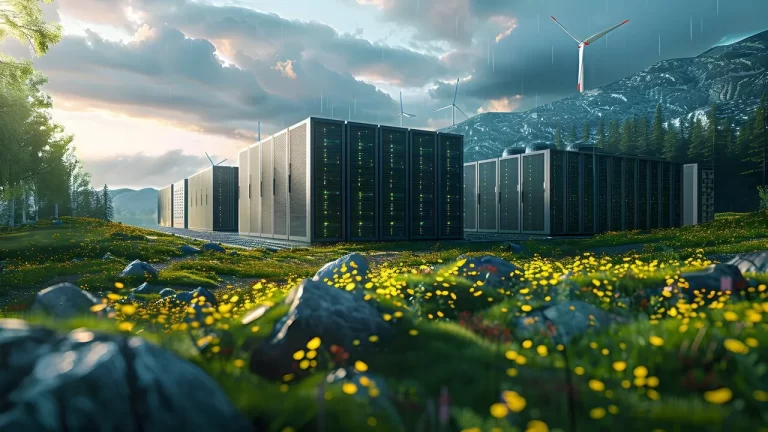Artificial Intelligence (AI) is bringing revolution in industries – from healthcare to finance, from retail to logistics. But behind the scenes, an often unseen challenge is: AI’s fastly growing energy demand, especially within data centers.

1. The AI Boom and Its Impact on Data Centers
The past few years have seen a massive increase in AI use. From the ChatGPT of OpenAI’s to automated robotics and self-driving techniques, the demand for high-demonstration computing (HPC) data centers has skyrocketed. AI requires huge processing power, which depends a lot on the hypersscale cloud computing data centers produced by companies such as Google, Microsoft and Amazon.
These data centers aren’t just large—they’re smart, relying on unified computing systems, network server racks, and data center automation software to handle complex AI tasks efficiently. Microsoft AI data center spending alone crossed billions in 2024, reinforcing how important infrastructure has become in the AI race.
2. Why AI Workloads Consume So Much Energy
AI workloads, especially those powered by deep learning models, are inherently energy-intensive. A single AI model needs to be fed volumes of data many times larger than mega-sized, like terabytes or petabytes, which are stored in cloud infrastructure across different data centers. The use of these large data sets improves both how accurate and how well models perform, yet this also puts greater strain on the processing. Access and computation needs nowadays put more strain on servers and the power systems supporting them.
Also, AI uses hardware such as GPUs and TPUs, which use much more energy than common CPUs. These chips are optimized for parallel processing but generate immense heat, requiring advanced cooling systems within unified computing systems and network server rack environments. Chatbots, recommendation engines, and autonomous systems constantly running in real-time for AI inference lead to constant use of a lot of power. Today, operators guard against complexity by adding firewall protection for data centers, hosting, and compute centers and better automation tools. These tools help optimize workflows, improve energy efficiency, and automate routine management tasks, all while implementing data center optimization techniques that reduce overhead and enhance performance.
3. The Role of Hyperscale and Cloud Data Centers
AI’s hunger for compute has led to a global boom in hyperscale computing companies. Tech giants are expanding their presence in Azure regions, building massive Microsoft datacenters, Google data centers, and Ctrl’s datacenters ltd facilities to support cloud-based AI.
These hyperscale sites are often powered by a mix of public cloud data centers and colocation cloud setups. Colocation vs managed hosting vs cloud has become a key strategic decision for businesses. While cloud colocation pricing remains competitive, the need for custom infrastructure is pushing companies to explore colo data centers and QTS data centers for better control and scalability.
To efficiently run these sites, companies are integrating data center and DCIM (Data Center Infrastructure Management) solutions that monitor energy consumption, automate processes, and ensure uptime—essential in an AI-powered world.

4. Environmental Concerns and Sustainability Challenges
As AI workloads scale, the environmental footprint of data centers is rapidly expanding. The power consumption associated with training and deploying large models can be immense—some AI tasks are known to consume as much energy as entire small towns. This puts additional strain on local energy grids, especially in areas housing hyperscale facilities operated by hyperscale computing companies. As these companies expand to meet demand, including across multiple Azure regions and Microsoft datacenters, their cumulative power usage is creating serious sustainability concerns.
Another important environmental problem is how we manage cooling infrastructure. Having many powerful servers means the hardware needs advanced cooling. In many data centers, the original air-cooling systems are still used which leads to high use of water and energy. Unless these systems are powered by renewable energy, the result is a substantial carbon footprint. In response, organizations are increasingly turning to green tech investments. They’re integrating data center automation software and intelligent DCIM (Data Center Infrastructure Management) solutions to monitor power usage, automate load balancing, and support more sustainable colocation cloud strategies. These solutions help balance performance with energy efficiency, providing a flexible and environmentally responsible approach to managing modern AI workloads.
5. Can AI Fix Its Energy Problem? (Solutions and Innovations)
Ironically, AI may also be the key to solving its own energy dilemma. Tech companies are now leveraging AI to manage and optimize data center operations. These energy-aware algorithms can analyze usage patterns, predict performance spikes, and make real-time adjustments to power distribution and cooling. For example, Google data centers have implemented AI-driven thermal optimization systems that have successfully cut cooling energy consumption by up to 40%. They make operations more energy-efficient and less costly, so organizations using colocation, managed hosting, or the cloud are attracted to these results.
A promising new idea called immersion cooling involves suspending servers in liquid that easily draws away and dumps heat. This method takes up less space and needs less air conditioning than the old air-based method. Additionally, cloud-hybrid deployments are gaining traction. These combine colocation cloud, public cloud data centers, and on-prem infrastructure to balance performance, security, and cost-efficiency. Businesses leveraging these models benefit from lower cloud colocation pricing while maintaining scalability and resilience. Forward-thinking operators are also adopting data center automation tools to monitor real-time energy consumption, forecast resource needs, and optimize compute resources dynamically. When combined with modern colocation cloud setups, these innovations provide a pathway toward a scalable, energy-conscious infrastructure for AI’s continued growth.
Conclusion
AI’s progress is interesting, but it is very energy-intensive. Because more and more work is being done with automation, natural language, and machine learning, data centers are under increasing pressure.
Optimizing data centers, using green energy, and upgrading infrastructure will be important to support AI’s future wisely. Expansion of data centers, using colocation or shifting to public cloud, the intent is to ensure AI keeps growing while using as little energy as possible.
Companies now use DCIM, firewalls, smart automation, and new hosting approaches, leading the data center industry to focus on innovation and sustainability.








